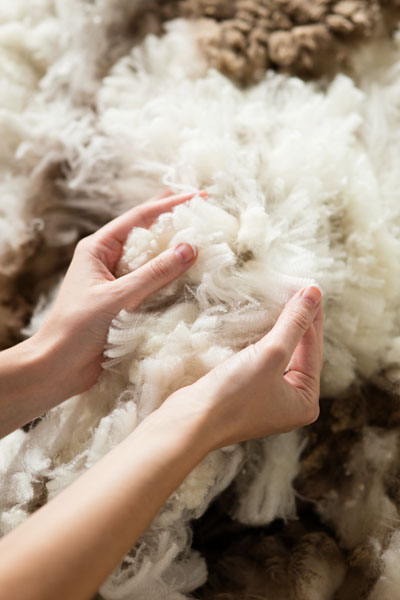When thinking about sustainable material options, it’s hard to find a perfect option. That being said, I’ve found that alpaca and merino wool from Latin America offer some of the cleanest and most transparent supply chains from which to source. Because you can follow the production process from start to finish, you can trust in the final product.
Peru is very well known as a source of alpaca but I’ve found from my travels that Bolivia is another destination worth looking into for similar quality material. In both countries, you will be able to see the supply chain in full, from where the alpaca is sourced to where it’s turned into a finished product.
The alpaca industry in Peru has exploded over the last few years, with many designers choosing to travel to the country to get as close as they can to the source. Because of that increased demand, alpaca factories have increased their industrial yarn offerings. Nevertheless, you still have to do your research when sourcing the fiber: ask many questions, follow the process, and build a relationship with your partners. Even though you may find a fair-trade supplier of hand-woven knitwear, for example, you still have to ask where they source their yarns. If it’s from a factory the fiber can often be a synthetic substitute. There are many clean supply chain options, but you have to take the time to research and inquire.
When evaluating a supplier, here are some tips:
- Look for certifications. See if they have any Fair-Trade certifications validated by the Fair-Trade Federation or the WFTO.
- Visit their facility. Seeing first-hand is the best way to trust the partnership. Ask to visit the farms where the alpaca is sourced, the factories where the raw fiber is spun into yarn, and the workshop where the goods are made into finished products.
- Ask to see a catalogue and price list. How they respond to your emails will give you a good sense for how professional they are. You need a partner that is socially and environmentally conscious but also one that responds in a timely, organized manner. My test is usually – do they respond within 24 hours? I require quick responses when vetting for new partners!
- Reach out for photos and more information. If you can’t visit, ask them to send photos of their workshop, ask them where they are sourcing their raw material along with where they are sourcing the yarns.
- Choose quality over quantity. When sourcing, I always suggest developing fewer but stronger partnerships, as you can spend more time evaluating their supply chain, ensuring the process is clean as well as socially and environmental conscious. You’ll also save more on annual visits if you don’t have as many partners to check in with.
Production of alpaca exists on a smaller scale in Bolivia but I often prefer sourcing from Bolivian suppliers because the quality of their fibers is just as high, if not higher, and the country’s alpaca industry is in greater need of support. It gets less funding from the government for buyer trips so the alpaca production in this area is much less explored.
I also like looking at Uruguay for its incredible merino wool. There are a few fair-trade enterprises you can find that have a 100 percent transparent supply chain. They not only work with local farmers to source high-quality wool, but they support local weavers in remote communities that turn the fiber into garments, throws, and other finished products. They dye the yarn in small batches which are available to purchase by the spool or as a finished product.
Sourcing sustainable fibers like alpaca and merino wool is dictated in large part by the quantities and quality you’re looking for. For larger production, most people go to Peru but I suggest supporting smaller enterprises which can be found at trade shows like the Peru Moda Gift Show or, if you’d prefer, you can contact me directly for sourcing inquiries based on your specific needs.



